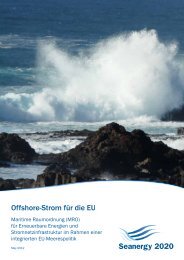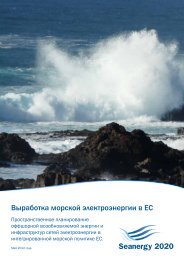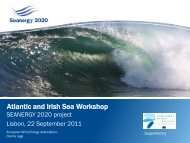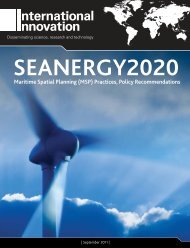Comparative analysis of Maritime Spatial Planning ... - Seanergy 2020
Comparative analysis of Maritime Spatial Planning ... - Seanergy 2020
Comparative analysis of Maritime Spatial Planning ... - Seanergy 2020
You also want an ePaper? Increase the reach of your titles
YUMPU automatically turns print PDFs into web optimized ePapers that Google loves.
Economy/sustainable developmentProject developerShipping/navigationPortsCustoms/Enforcement agenciesFishing and AquacultureTourism/recreation/landscapeCultural Heritage/archaeologyNature conservation/environmentSand/gravel extractionOil & GasOffshore renewablesEnergy distribution and pipelinesDefence/RadarAir trafficNGOsLocal communitiesPublicResearch/universitiesExperience in regional MSP programmes suggests that it is important to avoid large numbers <strong>of</strong>stakeholders within the consultation process as it may hamper constructive discussion and agreement(Plancoast, 2008). In this sense, it may be more efficient to set up associations that represent stakeholdergroups and act as a focal point for governments. For instance in the UK, various stakeholder groups havebeen established to help deal with specific sector issues including NOREL to deal with navigation issues;FLOWW to deal with fisheries and OREEF for environmental issues.Consultations can also be more effective if coordinated by one institution. For example in Scotland there isone central agency (Marine Scotland) responsible for planning <strong>of</strong> marine renewables and organisingconsultations for individual projects. Marine Scotland uses its expertise to determine which stakeholdersneed to be consulted and what areas need more or less attention, and ensures that there is significantinformal consultation before the formal process starts to quickly identify and seek to resolve conflicts. Thisis also the case in Germany where the Federal <strong>Maritime</strong> and Hydrography Agency (BSH) coordinates allconsultation for MSP in the EEZ.5.3.2 Consultation on Plans and ProjectsAs all EU member states are required to translate the EIA Directive into national legislation, there is theprovision in all countries for stakeholder consultation on individual development projects as part <strong>of</strong> thepermitting process. The degree to which consultation takes place and the degree <strong>of</strong> stakeholderinvolvement, however, varies considerably between the different countries. For example in the UKstakeholders are actively involved in the consultation process and comments are actively sought fromrepresentative groups. In contrast, while consultation is still a legal requirement in countries such asEstonia, Latvia and Greece, details <strong>of</strong> new O-RE projects are not actively sent to specified groups but thesystem relies on groups accessing proposals and sending in comments.Deliverable 2.331 | P a g e






